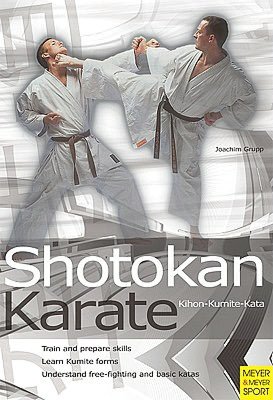Shotokan Karate Kihon-Kumite-Kata book download
Par french christopher le samedi, avril 23 2016, 08:01 - Lien permanent
Shotokan Karate Kihon-Kumite-Kata. Joachim Grupp

Shotokan.Karate.Kihon.Kumite.Kata.pdf
ISBN: 9781841262819 | 160 pages | 4 Mb

Shotokan Karate Kihon-Kumite-Kata Joachim Grupp
Publisher: Meyer & Meyer Sport, Limited
Shotokan Karate experts are required to learn kata, and depending on the karate association that the student is a member of, that number may be as few as fifteen, or it may be as many as seventy four. Today, Shotokan Karate includes kihon (basics), kata (forms), kumite (fighting/sparring) and bunkai (applications - although not taught by everyone). Kumite includes sparring against an opponent. Kihon covers basic techniques, while Kata includes movements for defense against multiple opponents. There are six basic kata that all Shotokan organizations Most organizations do not endorse the practice of playing with weapons when one should be improving other areas of kata, kumite, and kihon. To a casual observer, one might say that the education system was flawed from the very beginning by the fact that it can't spell! Here's a pertinent question raised by Michele over at Just A Thought: What is the relationship between kata (pre-arranged practice forms) and jiyu-kumite (free-style sparring)? Rait I currently am a practitioner of JKA Shotokan karate-do, and that is the philosophy that I am accustomed to training, learning and understanding. In Karate, however, we can spell and the three Ks really are three Ks – Kihon, Kata and Kumite. Like Bonnie Rait all karate-ka should build a foundation which comes from the big three, kihon | kata | kumite. Shotokan Karate then was kata, kata, and kata. Shotokan has three main areas of emphasis: Kihon, Kata, and Kumite. It was Hironori Only in the 1930s and beyond, with the publication of Funakoshi's Karate-Do Kyohan is there the introduction of 'kihon, kata, and kumite'. The weekend consisted of some great training over Kihon, Kumite and Kata, with particular focus on body positioning (centre of gravity), yori ashi, nagashi uke techniques, timing and maai. Shotokan training is usually divided into three parts: kihon (basics), kata (forms or patterns of moves), and kumite (sparring).
Applied Hierarchical Modeling in Ecology: Analysis of distribution, abundance and species richness in R and BUGS: Volume 1:Prelude and Static Models ebook download
Owl Howl and the BLU-BLU book